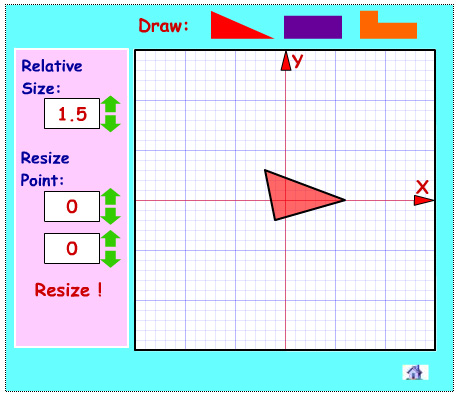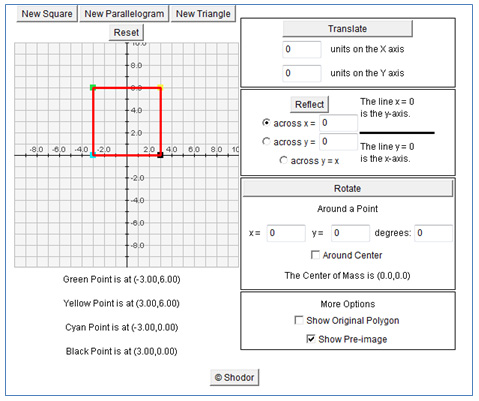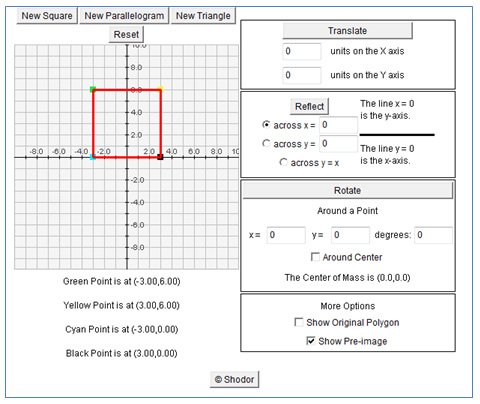Introduction
 Transforming polygons is an important application of coordinate geometry. Graphics designers, video game producers, and computer animation artists all use coordinate transformations, including dilations, translations, and reflections, to generate digitally-designed art.
Transforming polygons is an important application of coordinate geometry. Graphics designers, video game producers, and computer animation artists all use coordinate transformations, including dilations, translations, and reflections, to generate digitally-designed art.
In this resource, you will investigate coordinate transformations, including dilations, translations, and reflections.

Dilations are transformations that generate an enlargement or a reduction.

Translations are congruence transformations that move an object, without changing its size or shape. Usually, a coordinate plane is used in order to track the location of the object.
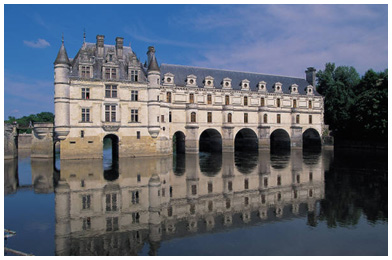
Reflections are congruence transformations that generate a mirror image of an object, without changing its size or shape.
Graphing Dilations
Dilations can be performed on a coordinate plane. A dilation can be either an enlargement, which results in an image that is larger than the original figure, or a reduction, which results in an image that is smaller than the original figure.
To perform a dilation on a coordinate plane, you need to know two pieces of information. First, you need to know the scale factor, or magnitude of the enlargement or reduction. Second, you need a center of dilation, or reference point from which the dilation is generated.
Click on the sketch below to access the interactive and investigate coordinate dilations. Once you have done so, use your experiences to answer the questions that follow.
Perform dilations with a triangle, a rectangle, and a hexagon. Choose relative sizes (scale factors) less than 1 as well as greater than 1. Choose resize points (center of dilation) of the origin, (0, 0), as well as other points in the coordinate plane.
Click to see additional instructions in using the interactive sketch.
- What types of scale factor will generate a reduction?
- What types of scale factor will generate an enlargement?
Use the same interactive sketch to complete the following table. Reset the sketch and place the triangle on the coordinate grid. Make sure that the center of dilation is the origin, (0, 0).
Make a copy of the table and paste it into your notes. Fill in the columns for Original Coordinates and Dilated Coordinates.
|
Original Coordinates |
Scale Factor |
Dilated Coordinates |
|
|
0.5 |
|
|
|
0.5 |
|
|
|
0.5 |
|
|
|
2 |
|
|
|
2 |
|
|
|
2 |
|
Use your completed table to answer the questions that follow.
- What patterns do you observe in the coordinates?
- How could you express that relationship using an algebraic rule?
Graphing Reflections
In the previous section, you investigated coordinate dilations. Dilations are transformations that preserve the shape of a polygon or an object, but the size changes. Reflections are congruence transformations. That is, a reflection is a transformation that preserves both size and shape of a polygon or object. In this section of the resource, you will investigate reflections that are performed on the coordinate plane.
Use the interactive link shown below to investigate coordinate reflections. Reflect a square, a parallelogram, and a triangle. Reflect these objects across the x-axis, the y-axis, and the line y = x. Once you have done so, use your experiences to answer the questions that follow.
Click on the sketch below to access the interactive and perform coordinate reflections.
Click to see additional instructions in using the interactive sketch.
Part 1: Reflections Across the x-axis
Use the interactive sketch to complete the following table. Reset the sketch and place a new parallelogram on the coordinate grid. Make a copy of the table and paste it into your notes. Fill in the columns for Original Coordinates. Translate your parallelogram across the x-axis and then record the reflected coordinates. Repeat a reflection for a second new parallelogram.
|
Reflect Across |
Original Coordinates |
Reflected Coordinates |
|
Green |
|
|
|
Yellow |
|
|
|
Cyan |
|
|
|
Black |
|
|
|
Green |
|
|
|
Yellow |
|
|
|
Cyan |
|
|
|
Black |
|
|
Use your completed table to answer the questions that follow.
- What patterns do you observe in the coordinates?
- How could you express that relationship using an algebraic rule?
Part 2: Reflections Across the y-axis
Use the interactive sketch to complete the following table. Reset the sketch and place a new parallelogram on the coordinate grid. Make a copy of the table and paste it into your notes. Fill in the columns for Original Coordinates. Reflect your parallelogram across the y-axis and then record the reflected coordinates. Repeat a reflection for a second new parallelogram.
|
Reflect Across |
Original Coordinates |
Reflected Coordinates |
|
Green |
|
|
|
Yellow |
|
|
|
Cyan |
|
|
|
Black |
|
|
|
Green |
|
|
|
Yellow |
|
|
|
Cyan |
|
|
|
Black |
|
|
Use your completed table to answer the questions that follow.
- What patterns do you observe in the coordinates?
- How could you express that relationship using an algebraic rule?
Part 3: Reflections Across the Line y = x
Use the interactive sketch to complete the following table. Reset the sketch and place a new parallelogram on the coordinate grid. Make a copy of the table and paste it into your notes. Fill in the columns for Original Coordinates. Reflect your parallelogram across the line y = x and then record the reflected coordinates. Repeat a reflection for a second new parallelogram.
|
Reflect Across |
Original Coordinates |
Reflected Coordinates |
|
Green |
|
|
|
Yellow |
|
|
|
Cyan |
|
|
|
Black |
|
|
|
Green |
|
|
|
Yellow |
|
|
|
Cyan |
|
|
|
Black |
|
|
Use your completed table to answer the questions that follow.
- What patterns do you observe in the coordinates?
- How could you express that relationship using an algebraic rule?
Practice
Pentagon PENTA has coordinates at P (−4, 3), E (0, 7), N (4, 8), T (6, 1), and A (2, −2).
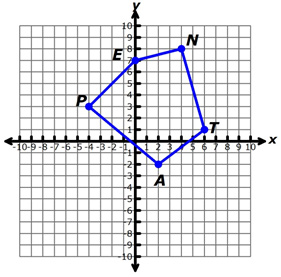
- What are the coordinates of each vertex after the pentagon is reflected across the x-axis?
- What are the coordinates of the reflection of pentagon PENTA after it is reflected across the y-axis?
- What are the coordinates of the reflection of pentagon PENTA after it is reflected across the line y = x?
Graphing Translations
Another type of congruence transformation is a translation. A translation is a transformation in which a polygon, or other object, is moved along a straight-line path across a coordinate or non-coordinate plane. Translations do not change the size, shape, or orientation of a figure; they only change the location of a figure.
In this section of the resource, you will investigate translations that are performed on the coordinate plane.
Click on the interactive sketch below to perform coordinate translations. Use the buttons labeled “New Square,” “New Parallelogram,” and “New Triangle” to generate a new polygon on the coordinate plane. Use the box containing the translate button to indicate the direction of the translation.
Click to see additional instructions in using the interactive sketch.
Use the interactive sketch to complete the following table. Reset the sketch and place a new parallelogram on the coordinate grid. Make a copy of the table and paste it into your notes. Fill in the columns for Original Coordinates. Translate your parallelogram according to the direction of translation, then record the reflected coordinates. Repeat a reflection for a second new parallelogram.
|
Point |
Direction of Translation |
Original Coordinates |
Translated Coordinates |
|
Green |
3 units along x-axis |
|
|
|
Yellow |
|
|
|
|
Cyan |
|
|
|
|
Black |
|
|
|
|
Green |
−4 units along x-axis |
|
|
|
Yellow |
|
|
|
|
Cyan |
|
|
|
|
Black |
|
|
Use your completed table to answer the questions that follow.
- How do the x-coordinates of the translated coordinates compare to the x-coordinates of the original coordinates and the direction of translation?
- How do the y-coordinates of the translated coordinates compare to the y-coordinates of the original coordinates and the direction of translation?
- How does the sign of the translation affect the direction of the translation?
- How could you express a translation of h units in the x-direction and k units in the y-direction using an algebraic rule?
Practice
Hexagon ADVERB has coordinates at A (−3, 2), D (1, 3), V (4, 8), E (7, 2), R (3, −2), and B (−3, −4).
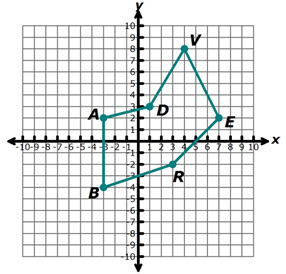
- If the hexagon is translated 3 units to the left and 4 units down, which points will lie in Quadrant III?
- What would be the coordinates of Point V' if hexagon ADVERB is translated 5 units to the right and 7 units down?
- Identify the new coordinates of Points R' and B' if hexagon ADVERB is translated according to the rule (x, y) → (x – 4, y + 5).
Summary
Coordinate transformations are very useful for a variety of reasons. As more information is presented digitally, the ability to precisely predict how images will change as they move around the screen is an essential 21st century skill. You will also apply coordinate transformations when you study functions in Algebra I.
